Non-Monotone Projected Gradient Method in Linear Elasticity Contact Problems with Given Friction
Abstract
1. Introduction
2. Problem Definition
- is a vector of unknown displacements in FEM nodes;
- is a set of feasible (non-penetrated) displacements;
- is a symmetric positive definite (SPD) stiffness matrix (the Dirichlet boundary condition is implemented by the modification of the stiffness matrix);
- is a vector of forces density resulting from the stresses imposed on the structure during a displacement (the discretized form of and );
- is a numerical integration of functional describing the friction forces in the weak formulation of the problem;
- are basis vectors formed by appropriately placed multiples of the unit tangential vectors in such a way that the jump of tangential displacement in i-th FEM node is given by ;
- are slip bound coefficients associated with .
3. Numerical Solution
| Algorithm 1: SPG for QP problems (SPG-QP, [5]) |
| Given a quadratic objective function with SPD and , closed convex feasible set , initial approximation , projection onto feasible set , parameters , safeguarding parameters , precision , and initial step-size . set index of iteration while stopping criterium is not safisfied compute matrix-vector multiplication compute multiple dot-product choose endwhile Return the approximation of solution and the number of performed iterations . |
4. Results
5. Conclusions
Author Contributions
Funding
Conflicts of Interest
References
- Hlaváček, I.; Haslinger, J.; Nečas, J.; Lovíšek, J. Solution of Variational Inequalities in Mechanics; Springer: Berlin, Germany, 1988. [Google Scholar]
- Reddy, J.N. An Introduction to the Finite Element Method; McGraw-Hill Education: New York, NY, USA, 1993. [Google Scholar]
- Brenner, S.; Scott, R. The Mathematical Theory of Finite Element Methods, 3rd ed.; Springer: Berlin/Heidelberg, Germany, 2008. [Google Scholar]
- Dostál, Z. Optimal Quadratic Programming Algorithms, with Applications to Variational Inequalities; SOIA, Springer: New York, NY, USA, 2009; Volume 23. [Google Scholar]
- Pospíšil, L.; Gagliardini, P.; Sawyer, W.; Horenko, I. On a scalable nonparametric denoising of time series signals. Commun. Appl. Math. Comput. Sci. 2018, 13, 107–138. [Google Scholar] [CrossRef]
- Hestenes, M.R.; Stiefel, E. Methods of conjugate gradients for solving linear systems. J. Res. Natl. Bur. Stand. 1952, 49, 409–436. [Google Scholar] [CrossRef]
- Dostál, Z.; Pospíšil, L. Conjugate gradients for symmetric positive semidefinite least-squares problems. Int. J. Comput. Math. 2018, 95, 2229–2239. [Google Scholar] [CrossRef]
- Kružík, J.; Pecha, M.; Hapla, V.; Horák, D.; Čermák, M. Investigating Convergence of Linear SVM Implemented in PermonSVM Employing MPRGP Algorithm. In Proceedings of the International Conference on High Performance Computing in Science and Engineering, Karolinka, Czech Republic, 22–25 May 2017; pp. 115–129. [Google Scholar] [CrossRef]
- Pecha, M.; Čermák, M. Analyzing l1-loss and l2-loss Support Vector Machines Implemented in PERMON Toolbox. Int. Conf. Adv. Eng. Theory Appl. 2018, 13–23. [Google Scholar] [CrossRef]
- Nocedal, J.; Wright, S.J. Numerical Optimization, 2nd ed.; Springer: New York, NY, USA, 2006. [Google Scholar]
- Boyd, S.; Vandenberghe, L. Convex Optimization; Cambridge University Press: Cambridge, UK, 2004. [Google Scholar]
- Dostál, Z.; Pospíšil, L. Optimal iterative QP and QPQC algorithms. Ann. Oper. Res. 2016, 243, 5–18. [Google Scholar] [CrossRef]
- Hapla, V.; Horák, D.; Pospíšil, L.; Čermák, M.; Vašatová, A.; Sojka, R. Solving Contact Mechanics Problems with PERMON. In High Performance Computing in Science and Engineering; Kozubek, T., Blaheta, R., Šístek, J., Rozložník, M., Čermák, M., Eds.; Springer International Publishing: Zurich, Switzerland, 2016; pp. 101–115. [Google Scholar]
- Dostál, Z.; Horák, D.; Kučera, R.; Vondrák, V.; Haslinger, J.; Dobiáš, J.; Pták, S. FETI based algorithms for contact problems: Scalability, large displacements and 3D coulomb friction. Comput. Methods Appl. Mech. Eng. 2005, 194, 395–409. [Google Scholar] [CrossRef]
- Farhat, C.; Roux, F.X. A method of finite element tearing and interconnecting and its parallel solution algorithm. Int. J. Numer. Methods Eng. 1991, 32, 1205–1227. [Google Scholar] [CrossRef]
- Dostál, Z.; Horák, D.; Kučera, R. Total FETI—An easier implementable variant of the FETI method for numerical solution of elliptic PDE. Commun. Numer. Methods Eng. 2006, 22, 1155–1162. [Google Scholar] [CrossRef]
- Kruis, J. Domain Decomposition Methods on Parallel Computers. In Progress in Engineering Computational Technology; Topping, B.H.V., Mota Soares, C.A., Eds.; Saxe-Coburg Publications: Stirling, UK, 2004; pp. 299–322. ISBN 1-874672-22-9. [Google Scholar]
- Medek, O.; Kruis, J.; Bittnar, Z.; Tvrdík, P. Static Load Balancing Applied to Schur Complement Method. Comput. Struct. 2007, 85, 489–498. [Google Scholar] [CrossRef]
- Kruis, J. The FETI Method and its Applications: A Review. In Parallel, Distributed and Grid Computing for Engineering; Topping, B., Iványi, P., Eds.; Saxe-Coburg Publications: Stirling, UK, 2009; pp. 199–216. ISBN 978-1-874672-41-8/1759-3158. [Google Scholar]
- Kruis, J.; Matouš, K.; Dostál, Z. Solving laminated plates by domain decomposition. Adv. Eng. Softw. 2002, 33, 445–452. [Google Scholar] [CrossRef]
- Kruis, J. Domain Decomposition Methods for Distributed Computing; Saxe-Coburg Publications: Stirling, UK, 2006; ISBN-13: 978-1-874672-23-4. [Google Scholar]
- Dostál, Z.; Kučera, R. An Optimal Algorithm for Minimization of Quadratic Functions with Bounded Spectrum Subject to Separable Convex Inequality and Linear Equality Constraints. SIAM J. Optim. 2010, 20, 2913–2938. [Google Scholar] [CrossRef]
- Bouchala, J.; Dostál, Z.; Kozubek, T.; Pospíšil, L.; Vodstrčil, P. On the solution of convex QPQC problems with elliptic and other separable constraints. Appl. Math. Comput. 2014, 247, 848–864. [Google Scholar] [CrossRef]
- Dostál, Z.; Kozubek, T.; Markopoulos, A.; Brzobohatý, T.; Vondrák, V.; Horyl, P. A theoretically supported scalable TFETI algorithm for the solution of multibody 3D contact problems with friction. Comput. Methods Appl. Mech. Eng. 2012, 110–120. [Google Scholar] [CrossRef]
- Wright, S.J. Primal-Dual Interior-Point Methods; Society for Industrial and Applied Mathematics: Philadelphia, PA, USA, 1997. [Google Scholar]
- Pospíšil, L.; Dostál, Z. The Projected Barzilai-Borwein Method with Fall-Back for Strictly Convex QCQP Problems with Separable Constraints. Math. Comput. Simul. 2018, 145, 79–89. [Google Scholar] [CrossRef]
- Dai, Y.H.; Fletcher, R. Projected Barzilai-Borwein Methods for Large-Scale Box-Constrained Quadratic Programming. Numer. Math. 2005, 100, 21–47. [Google Scholar] [CrossRef]
- Nesterov, Y.E. A method for solving the convex programming problem with convergence rate O(1/k2). Dokl. Akad. Nauk SSSR 1983, 269, 543–547. [Google Scholar]
- Birgin, E.G.; Martínez, J.M.; Raydan, M.M. Nonmonotone spectral projected gradient methods on convex sets. SIAM J. Optim. 2000, 10, 1196–1211. [Google Scholar] [CrossRef]
- Alberty, J.; Carstensen, C.; Funken, S.A. Remarks around 50 line of Matlab: Short finite element implementation. Numer. Algorithms 1999, 20, 117–137. [Google Scholar] [CrossRef]
- Barzilai, J.; Borwein, J.M. Two point step size gradient methods. IMA J. Numer. Anal. 1988, 8, 141–148. [Google Scholar] [CrossRef]
- Raydan, M.M. Convergence Properties of the Barzilai and Borwein Gradient Method. Ph.D. Thesis, Rice University, Houston, TX, USA, 1991. [Google Scholar]
- Fletcher, R. On the Barzilai-Borwein Method. In Optimization and Control with Applications; Springer: Boston, MA, USA, 2005; pp. 235–256. [Google Scholar]
- Grippo, L.; Lampariello, F.; Lucidi, S. A Nonmonotone Line Search Technique for Newton’s Method. SIAM J. Numer. Anal. 1986, 23, 707–716. [Google Scholar] [CrossRef]
- Čermák, M.; Sysala, S.; Valdman, J. Efficient and flexible MATLAB implementation of 2D and 3D elastoplastic problems. Appl. Math. Comput. 2019, 355, 595–614. [Google Scholar] [CrossRef]
- Dostál, Z. On the decrease of a quadratic function along the projected-gradient path. Electron. Trans. Numer. Anal. 2008, 31, 25–29. [Google Scholar]
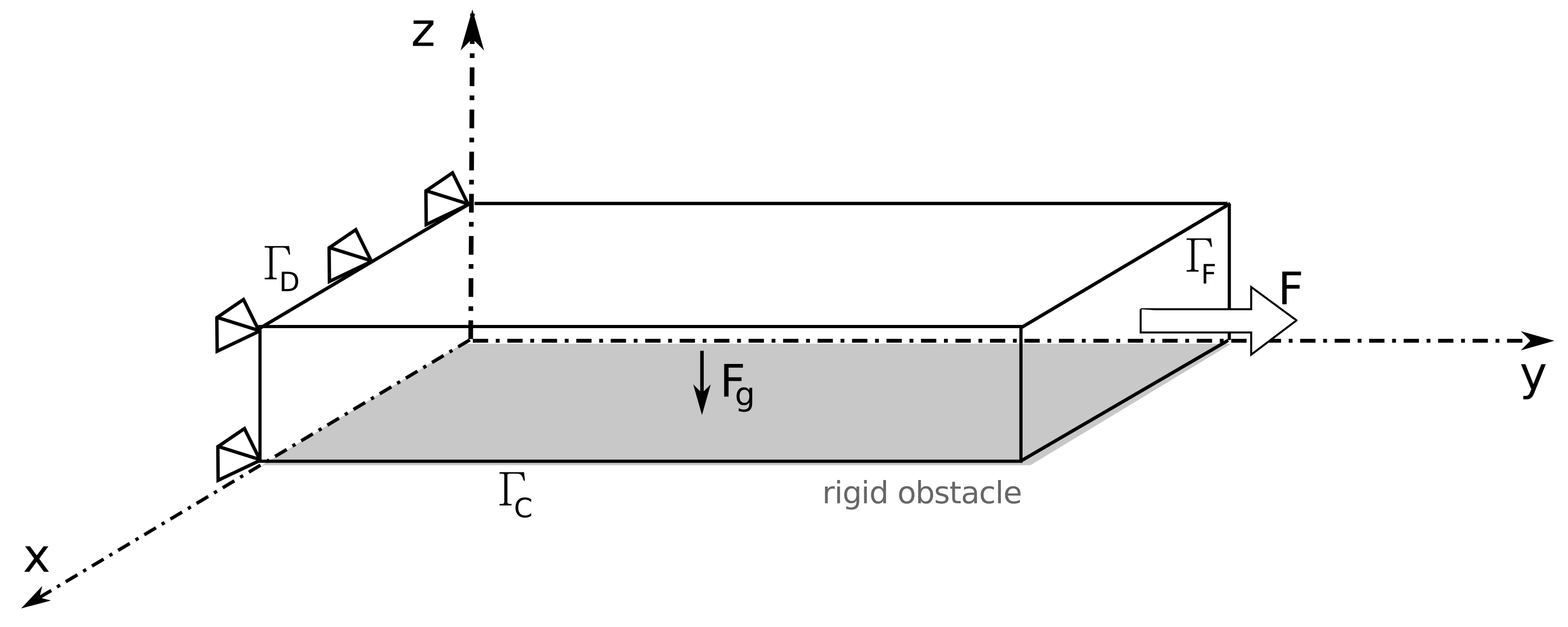
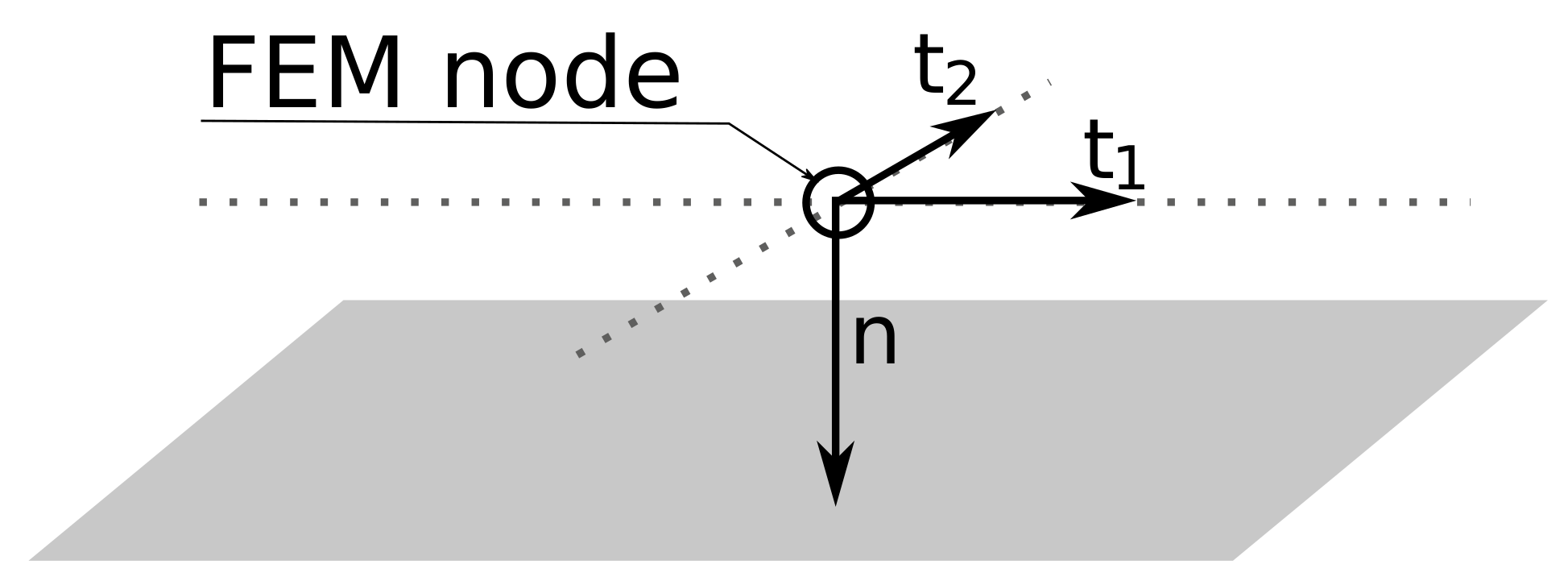
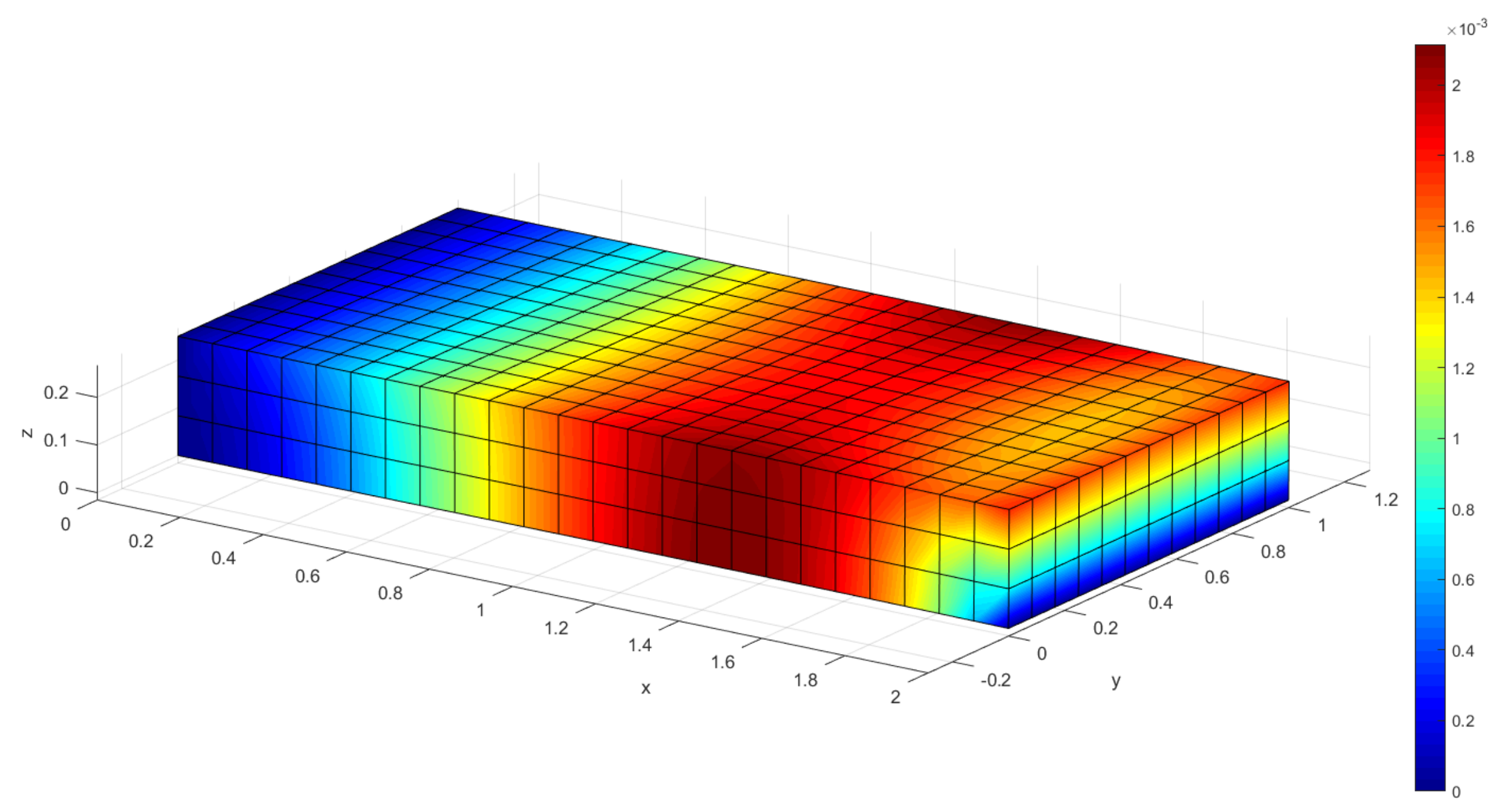
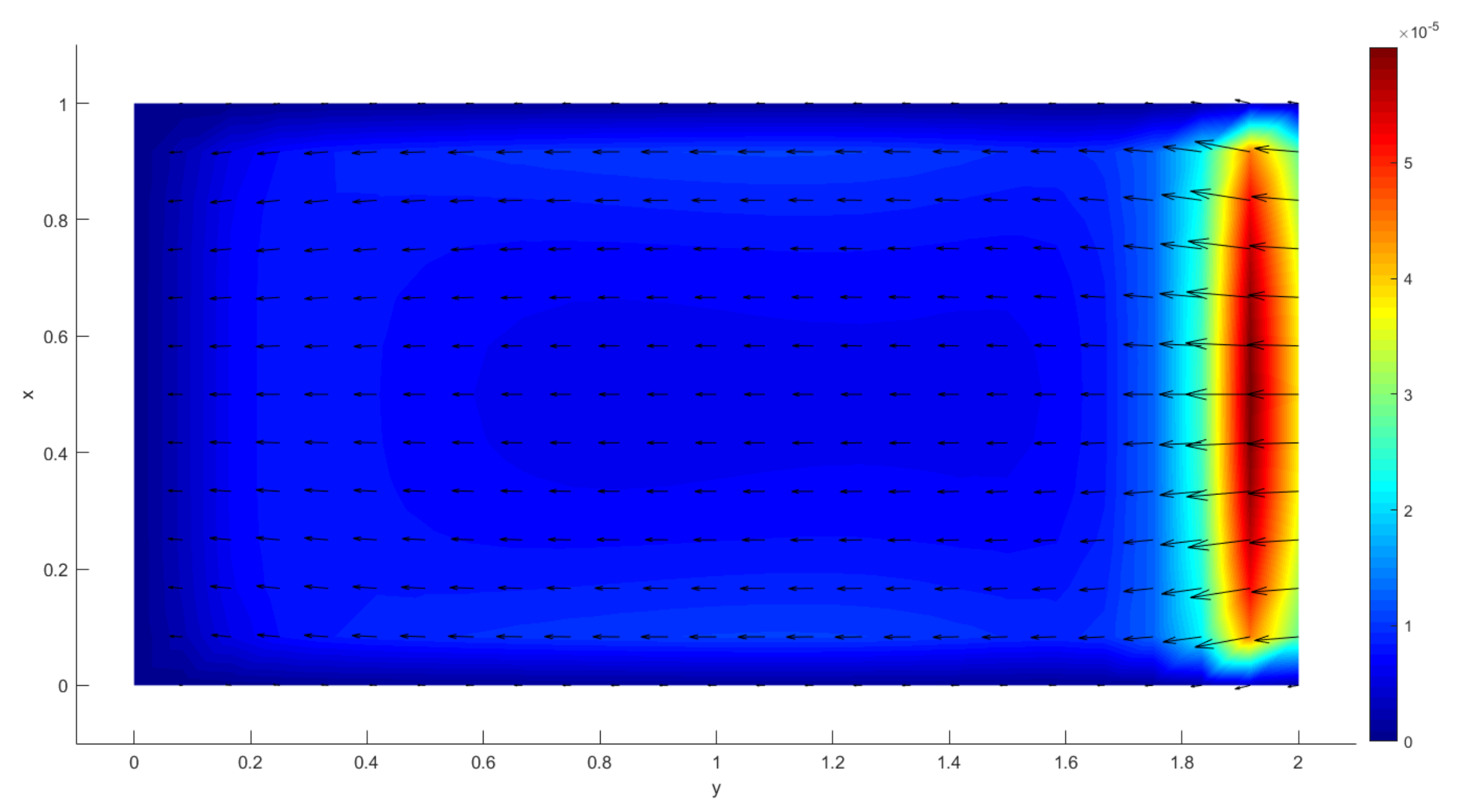

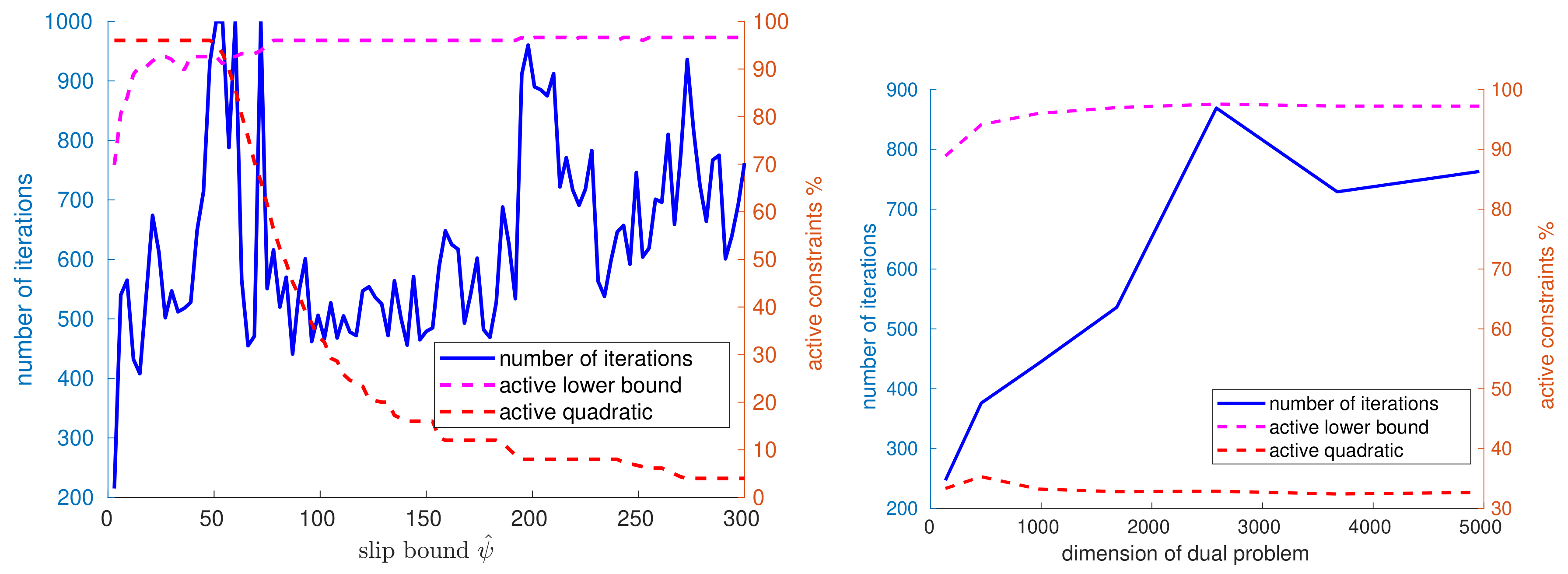
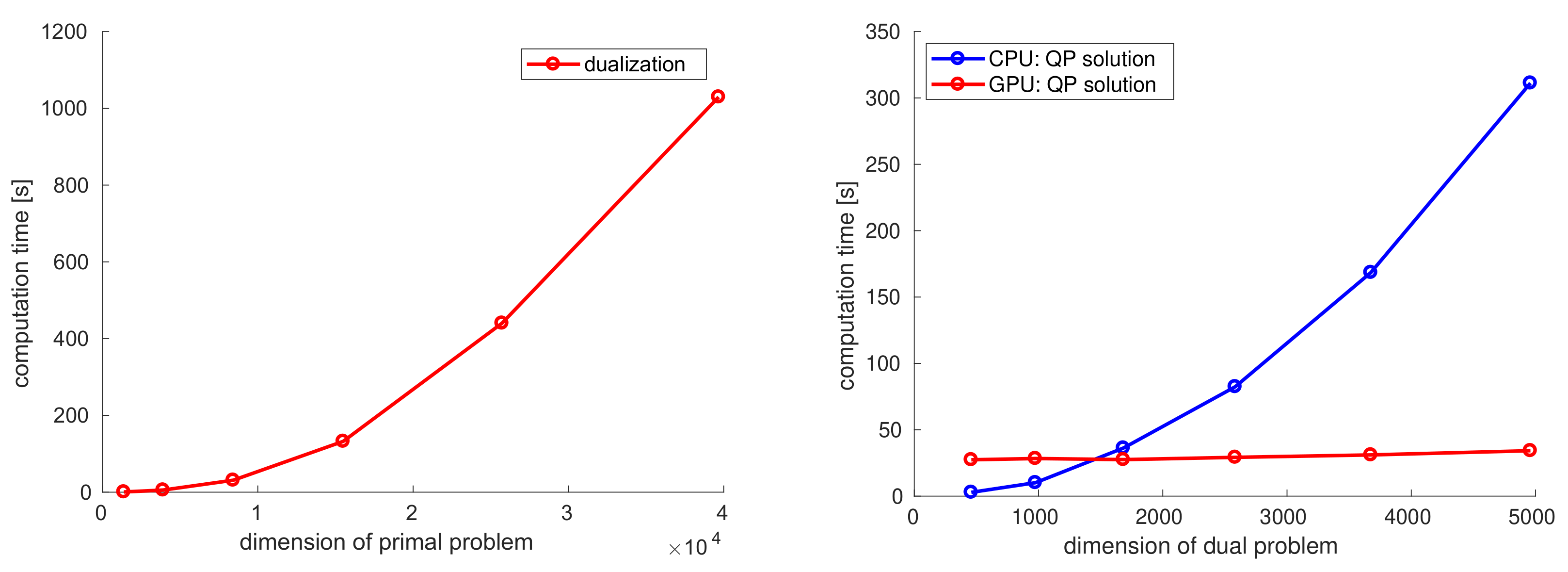
Publisher’s Note: MDPI stays neutral with regard to jurisdictional claims in published maps and institutional affiliations. |
© 2020 by the authors. Licensee MDPI, Basel, Switzerland. This article is an open access article distributed under the terms and conditions of the Creative Commons Attribution (CC BY) license (http://creativecommons.org/licenses/by/4.0/).
Share and Cite
Pospíšil, L.; Čermák, M.; Horák, D.; Kružík, J. Non-Monotone Projected Gradient Method in Linear Elasticity Contact Problems with Given Friction. Sustainability 2020, 12, 8674. https://doi.org/10.3390/su12208674
Pospíšil L, Čermák M, Horák D, Kružík J. Non-Monotone Projected Gradient Method in Linear Elasticity Contact Problems with Given Friction. Sustainability. 2020; 12(20):8674. https://doi.org/10.3390/su12208674
Chicago/Turabian StylePospíšil, Lukáš, Martin Čermák, David Horák, and Jakub Kružík. 2020. "Non-Monotone Projected Gradient Method in Linear Elasticity Contact Problems with Given Friction" Sustainability 12, no. 20: 8674. https://doi.org/10.3390/su12208674
APA StylePospíšil, L., Čermák, M., Horák, D., & Kružík, J. (2020). Non-Monotone Projected Gradient Method in Linear Elasticity Contact Problems with Given Friction. Sustainability, 12(20), 8674. https://doi.org/10.3390/su12208674




